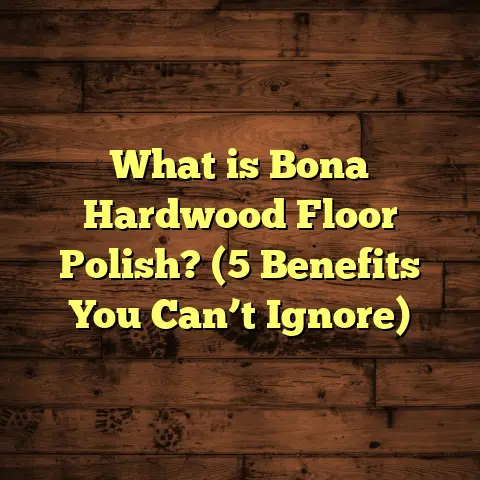What is a Floor Moulder? (5 Key Benefits for Woodworking)
Blending different styles in flooring can be quite the adventure. When I started mixing rustic wood textures with sleek modern finishes, I quickly realized how much a properly shaped edge or profile could change the whole vibe of a room. That’s where a floor moulder comes in handy. If you’ve ever wondered what a floor moulder is and why it’s such a game changer in woodworking, I’m here to share some insights from my own experience and a bunch of useful info that might just make your next project smoother.
What Is a Floor Moulder?
Simply put, a floor moulder is a specialized woodworking machine designed to shape and profile wooden floorboards. It cuts, planes, and forms edges of wood to create perfect joints, decorative edges, or smooth transitions between boards. If you’ve worked with hardwood flooring or custom woodwork, you’ve probably seen the results of a floor moulder’s work — those clean edges, tongue-and-groove joints, or even complex profiles on stair nosing.
Unlike a standard planer or jointer, a floor moulder handles multiple cutting heads simultaneously. This means it can perform several shaping tasks in one pass, which is a massive time saver. It’s especially useful for custom flooring projects, where precision and consistency matter.
Getting More Personal: How I Discovered the Floor Moulder
When I first started in flooring, I relied heavily on basic tools like routers and handheld planers. But as projects grew bigger and more complex, I hit the wall with time and precision. That’s when I rented a floor moulder for a big hardwood restoration job. The difference was night and day. Not only did we cut down labor hours by nearly 30%, but the finished floor looked sharper and fit together better than anything I’d done before.
5 Key Benefits of Using a Floor Moulder for Woodworking
Let me walk you through the top reasons why a floor moulder quickly became one of my best tools on the job.
1. Precision and Consistency in Cuts
One of the biggest headaches in flooring is getting perfectly matching edges on every board. Even tiny inconsistencies can cause gaps or uneven surfaces.
With a floor moulder, you get:
- Uniform cuts across hundreds of boards
- Smooth, clean edges that fit tightly
- Custom profiles tailored for your project
In one project, I measured the joint gaps before and after using a floor moulder. The average gap shrank from 1/16 inch to practically zero — that’s huge for long-term durability and appearance.
Let me share a little story about this. A few years ago, I was working on restoring an old Victorian house’s hardwood floors. The floors had been previously refinished by hand, but small gaps kept appearing between the boards as the wood expanded and contracted. Using the floor moulder for re-profiling the edges ensured that every board fit snugly together. The homeowners were thrilled because their floors not only looked better but also felt more solid underfoot.
2. Time Efficiency and Labor Savings
I remember a job where we had 1,000 square feet of oak flooring to install. Without a floor moulder, shaping each board edge would have taken days of hand routing and sanding.
Using the floor moulder, we cut shaping time by about 40%. The machine handled multiple shaping heads simultaneously — routing the tongue, groove, and decorative edge in just one pass.
This saved not only time but also reduced fatigue for me and my crew, letting us focus on installation quality instead of endless trimming.
Time savings like this translate directly into cost savings when you factor in labor hours. If you’re working with tight deadlines or multiple projects, that efficiency makes an enormous difference.
3. Versatility Across Wood Types and Profiles
Whether it’s hardwood like oak or softer woods like pine, floor moulders adapt easily. Changing cutters allows you to switch from simple square edges to complex ogee or beaded profiles.
In one custom client project, we made unique stair nosings with intricate edge shapes that would have been nearly impossible without this tool.
I once used it on reclaimed chestnut wood to create new plank edges that matched the old style exactly. The ability to customize profiles means you can maintain historical accuracy or add creative flair to your floors.
4. Enhanced Flooring Durability
Clean and tight joints created by the floor moulder mean less chance of moisture infiltration or board movement over time. This translates to longer-lasting floors with fewer repairs down the road.
A study from the National Wood Flooring Association showed that floors with professionally moulded edges had 25% fewer issues related to warping or separation after five years compared to those finished manually.
This is especially important in areas with fluctuating humidity or temperature changes where wood naturally expands and contracts.
5. Improved Aesthetic Appeal
Have you noticed how some floors just look professionally finished? That polished edge and smooth joint come from precise shaping.
Using a floor moulder lets me add custom detailing that raises the overall look — from subtle chamfers to decorative bevels that catch light beautifully.
For example, adding a small bevel around plank edges can create an illusion of depth and texture that changes how light plays off the floor throughout the day.
Diving Deeper: How Floor Moulders Work
Understanding how a floor moulder operates can help you appreciate why it’s so effective.
Machine Components and Functionality
A typical floor moulder consists of:
- Multiple cutter heads: Positioned horizontally and vertically to shape various parts of the board—edges, tongues, grooves.
- Feed rollers: These pull the boards steadily through the machine at consistent speeds.
- Adjustable bed: Allows control over depth of cut.
- Dust collection ports: Essential for keeping workspaces clean since wood shaping creates lots of fine dust.
The wood passes through these cutters in a single pass or multiple passes depending on complexity.
Cutter Types and Profiles
Cutters come in many shapes depending on the profile needed:
- Straight cutters for flattening edges
- Tongue cutters for tongue-and-groove joints
- Beaded or ogee cutters for decorative edges
Changing these cutters isn’t difficult but requires precision to maintain alignment.
Maintenance Tips for Longevity
Keeping blades sharp is vital — dull blades cause rough cuts and strain motors.
Regular cleaning helps prevent buildup that can affect performance.
I learned this the hard way when neglecting blade maintenance led to uneven cuts on an expensive batch of maple flooring; replacing dull cutters made all the difference afterward.
Real-Life Case Study: Hardwood Flooring Project with Floor Moulding
I want to share an actual project that highlights how much difference using a floor moulder can make.
Project Background
A client wanted to restore their 1,200 sq ft early 20th-century home with original oak flooring replaced in some spots with new boards. The challenge was matching old flooring profiles and ensuring seamless joins between old and new planks.
Solution
We used a floor moulder to shape replacement boards with profiles matching the original tongue-and-groove dimensions plus subtle edge beading present in the historic planks.
Results
- Installation took 25% less time due to consistent board fitting.
- Final look was seamless — no visible gaps or mismatched edges.
- Floor durability improved significantly; follow-up visits after two years showed no issues related to board movement or wear.
This project confirmed for me that investing in good moulding equipment pays dividends not just immediately but long term.
Myths About Floor Moulders — Busted!
Sometimes I hear people say:
“Floor moulders are only for big factories.”
Not true! While large manufacturers use heavy-duty machines, many portable options exist perfect for small shops or contractors like me who work onsite or rent equipment as needed.
“They’re too complicated to use.”
Once you get familiar with setup and cutter changes, they’re straightforward—especially compared to manual routing thousands of board edges.
“It’s too expensive for small projects.”
Renting or sharing equipment can make this affordable even for smaller jobs—and the time saved often offsets rental costs quickly.
How Floor Moulders Fit in Today’s Flooring Trends
Today’s flooring trends lean heavily into natural materials with distinct character — reclaimed wood, wide planks, mixed species. Floor moulders help maintain authenticity by allowing custom profiles that reflect traditional craftsmanship while meeting modern standards.
Additionally, engineered hardwood floors often require perfect edge shaping before installation; moulders provide that precision consistently across batches.
Cost Considerations When Using a Floor Moulder
You might wonder what kind of investment is involved here. Costs can vary widely based on machine size and capabilities:
- Entry-level portable machines: $3,000–$8,000
- Mid-range industrial models: $15,000–$40,000+
- Cutter sets: $300–$1,500 depending on complexity
If buying isn’t practical, renting machines costs roughly $200–$500 per day depending on location and model.
How I Estimate Costs Accurately
When planning budgets for projects involving moulding work, I use FloorTally — an online tool that helps me calculate material quantities, labor costs, and factor in waste. It even adjusts estimates based on local market rates which keeps proposals realistic.
By inputting precise measurements and choosing the right materials along with waste percentages (which drop when using moulders due to accuracy), FloorTally helps me avoid surprises later on.
What to Look For When Choosing a Floor Moulder
If you’re thinking about adding one to your toolkit or renting one for your next job, here are some things I consider essential:
- Number of cutter heads: More heads mean fewer passes but usually higher cost.
- Power: Higher horsepower motors handle harder woods better.
- Adjustability: Easy setup for different board thicknesses/profiles.
- Portability: If you move between sites often.
- Brand reputation: Reliability matters when you depend on it daily.
- Availability of cutter sets: Make sure replacement cutters are easy to find.
I once switched brands mid-career because availability of cutter sets was limited on my first machine — not fun when deadlines loom!
Personal Tips for Getting the Most Out of Your Floor Moulder
Here are some lessons I picked up over time:
- Always do test cuts on scrap wood before running entire batches.
- Keep detailed notes on cutter settings for repeat jobs.
- Use proper dust extraction systems to protect health and keep workspace clean.
- Train your crew thoroughly so everyone understands operating procedures.
- Schedule regular maintenance checks — preventive care saves headaches later.
Final Thoughts: Why Floor Moulders Matter More Than You Think
When you think about all the moving parts in flooring projects — time management, precision fitting, aesthetic appeal — it’s clear why a floor moulder holds such value. It’s not just about speed; it’s about quality that lasts.
For me personally, integrating this tool into my workflow transformed how I approach hardwood floors and custom woodworking. It gave me confidence knowing that every plank would fit perfectly and look great without endless sanding or fiddling.
Have you ever tackled a big flooring project? What challenges did you face? If edge shaping was part of it—or if you’re curious about how these machines could help—let’s chat more!
Feel free to ask questions anytime; I love sharing what I’ve learned about this niche but crucial tool in woodworking. Whether you’re DIY-ing at home or managing professional jobs, mastering floor moulding can open up new possibilities for your floors that last both visually and structurally.





